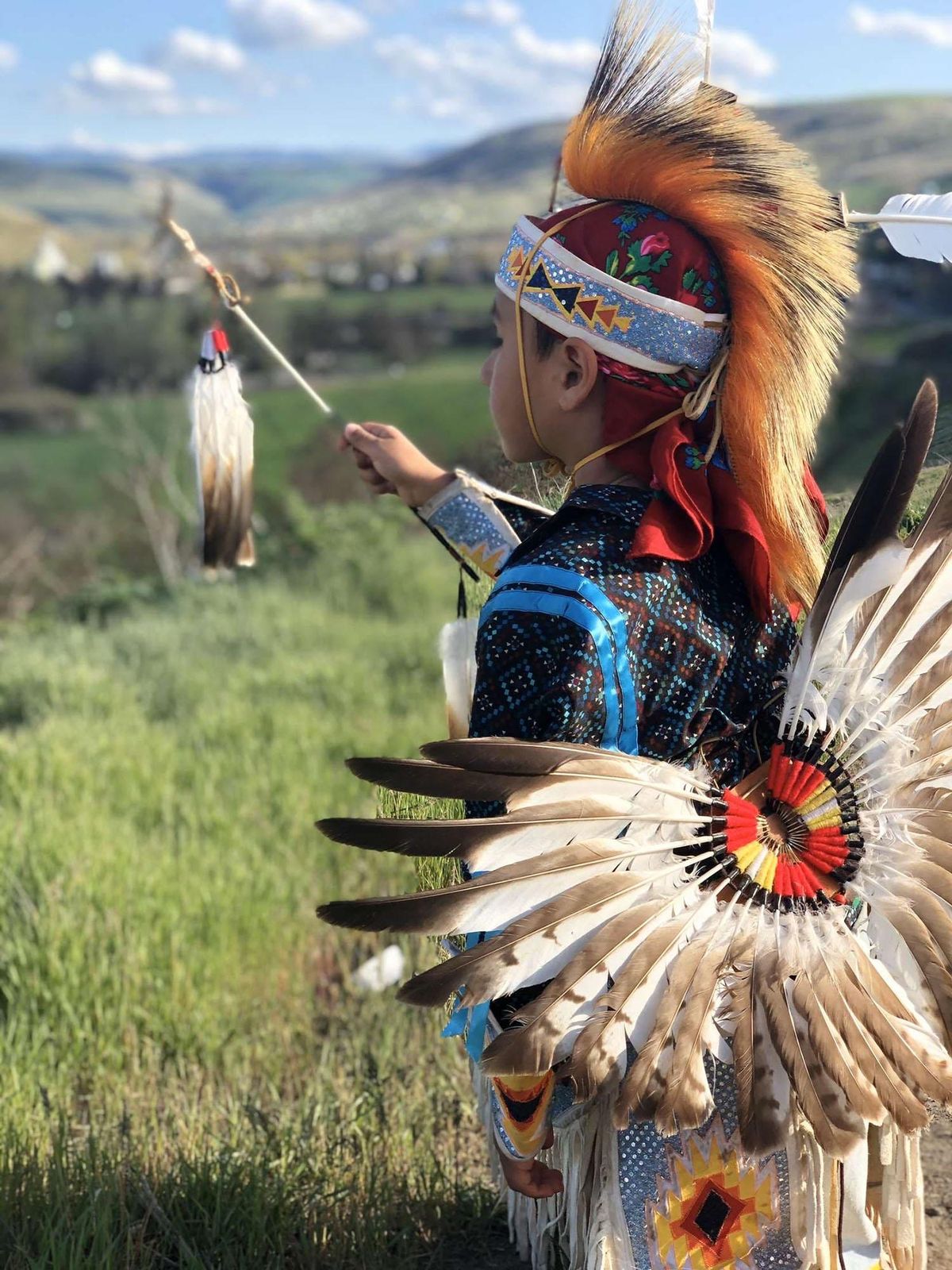‘We’re so resilient and it’s so beautiful’: Tribal members use technology to maintain tradition during quarantine

Six-year-old Talisau Moliga has been too shy to dance at the countless powwows his family attends every spring and summer, but from the comfort of his living room in Lapwai, Idaho, his style has earned him hundreds of shares on Facebook.
“Maybe my moves are good,” he said.
Talisau’s 14-year-old sister, Soa, had been planning to follow the powwow trail to several neighboring states this season, an expensive endeavor derailed by COVID-19 shutdowns. But she’s made the best of it by running Talisau’s tribal home schooling, teaching him their native Nez Perce language and encouraging him to dance.
The siblings decided to record Talisau dancing in full regalia for their grandmother, whom they’ve been unable to visit because of coronavirus. At a friend’s recommendation, Talisau’s mother, Taricia Moliga, posted the video to Facebook group Quarantine Dance Specials 2020.
The Moligias are among the thousands of American Indians across the country who have flooded the group with videos of songs and dances, amounting to more than 57,000 members posting nearly 6,000 videos per day. Other groups like Social Distance Powwow have cropped up with similar missions – to keep American Indians dancing during nationwide shutdowns.
And it’s more than a way to keep connected, Moliga said. To many Indians, dancing is prayer and medicine.
“People always say dance for those that can’t dance no more,” she said. “Watching them, it makes me so happy. It’s a feeling I can’t explain – especially with everything Indians have gone through. We’re so resilient and it’s so beautiful.”
Age doesn’t matter when it comes to prayer, said Ann Ford, who posted her dance to Facebook’s Social Distance Powwow group from the Spokane Reservation. Between her dance video and a post about her daughter’s work as a nurse, Ford has earned more than 3,000 likes.
But she didn’t dance for likes. She danced for healing across the world. Every dancer is, she said, even the littlest ones who might not know it.
“They’re too young to know about prayer but when they hear that drum, they know,” Ford said. “That love in their hearts is so powerful and so cute, too. Even when my grandson is being naughty, as soon as we turn drumming on he just gets so focused. They’re born into it. They know it, the heartbeat of our people.”
Hashkai Bird’s mother, Shibabe Abrahamson, agrees. Bird, 11, has been dancing competitively at powwows since he was a toddler and he’s not shy about his culture.
Abrahamson said her Cherokee and Navajo son has placed six times at the biggest powwow in the world, Gathering of Nations in Albuquerque, New Mexico.
They travel from their home on the Spokane Reservation in Ford, Washington, to New Mexico every year for the powwow and family visits.
At home, Bird has stood before an auditorium full of white classmates to demonstrate the Prairie Chicken Dance. He said he wasn’t afraid the first time because his mom danced by his side. The next time he wasn’t afraid because he’d done it before.
“I was showing what I could do when I was just a little kid, and what Natives could do,” he said.
He knows what he likes – dancing, hunting with his rifle or bow, playing traditional stickball and keeping his hair long per tradition. Sometimes waiters mistake him for a girl because of his long hair, but he’s not worried about it. He never gets teased and tells his mom his hair is the “source of his mojo.”
So he had no problem picking a spot at the end of his family’s driveway on the Spokane Reservation to stomp his heart out for a large audience again. This time instead of an award, he earned a thousand likes and nearly 700 shares in the Quarantine Dance Specials group.
Also on the Spokane Reservation, 6-year-old Kaleah Wallette’s mom, Jolene, reminded her that each step is a prayer for healing before she recorded Kaleah’s jingle dress submission.
Kaleah dances no matter what music is playing, but at home powwow music is a constant feature. Though Kaleah fell into dancing naturally and Wallette said she won’t force her to continue, she does want her daughter to know how meaningful each step really is.
“I told her, ‘When you get out there and dance, you’re praying for everyone around you,’ ” Wallette said. “When they do honor songs or prayer songs, it hits us differently. We know there’s something inside of us that’s uplifting.”
And Talisau, Hashkai, Kaleah and Ford are only a handful of local tribal members sharing their dances.
Vanessa Pete, a member of the Colville tribe living in Spokane, has posted singing, drumming and dancing in her jingle dress. She wrote that she was “dancing for good health for all of us.” Chad Browneagle from the Spokane and Kalispel tribes wore neon yellow regalia, asking a family member to post the video on his behalf.
From Lapwai, Nez Perce and Quinault tribe member Dana Sotomish wrote that she danced for all of her warrior sisters, to a response of nearly 700 likes and 70 comments of support.
While seeing people dressed in their regalia and dancing lifts Wallette’s heart, it’s still not enough to fill the void canceled powwows leave, she said. At a powwow, it’s more than one song – it’s vendors with Native American jewelry, traditional food and all the family and friends people meet on the powwow trail. It’s also a significant source of income for many people.
But they will get through this time of disconnection, Ford said.
“We’re a strong people,” Ford said. “We’re strong because we care for each other, we pray for each other and we know the importance of our traditions. … We’ll get through this, too.”